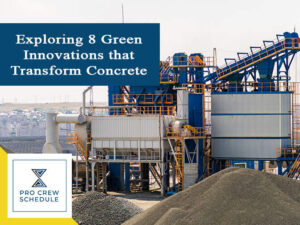In this developing world, the construction industry is currently at its peak. The industry’s enormous growth translates into increasing demand for building materials, laborers, and advanced tools like builder trends software. Concrete has remained to be one of the most valuable materials used in the construction. The significant elements in the standard production of concrete are aggregates, cement and sand.
For the last decades, the world has become aware of the residual products’ deposit problems. The industry has imposed several restrictions to control it further but later discovered that it wasn’t an efficient solution. The solution for it lies in searching alternatives that are green and economical and to ensure utilizing any of the emerging advanced technologies like construction scheduling software. Therefore, a few alternatives have been discovered and further explored and “Green Concrete” is one of these alternatives.
For this blog, green concrete will be outlined, including some of the best alternatives and innovations that ultimately transform concrete.
What is Green Concrete?
Green concrete refers to an environment-centered concept where every aspect starting from raw materials to its concrete mix design, structure design, or service life will be considered. This concept is proven to be very useful in so many cases. Not only is it economical and but also environment friendly.
Green concrete is generally made up of the utilization of waste materials. These waste materials are one of its primary components. Compared to traditional concrete, the green type of concrete produces less carbon dioxide and is considered more durable and inexpensive.
The goal of utilizing green concrete is to reduce the burden on natural resources and increase reliance on recyclable materials. As for crew schedule software, the purpose of using this tool is to improve the team collaboration significantly, therefore, boosting crew productivity. With the complex and multiple strategies being used to accomplish sustainability by eco-friendly concrete, re-utilizing water to lessen water consumption has been proven to be an excellent technique.
The Issues in Using Concrete
While concrete is widely considered as the most famous building tool over the years, the utilization of this building material has unfortunately taken a massive toll on the environment. With that being said, it comes at a high cost. Let’s now begin understanding how it affects the environment. Take a look below.
1. Carbon Dioxide emission
Cement is the largest ingredient in making or producing concrete. However, it involves a standard percentage of greenhouse emissions. According to a study, 8% to 10% of the world’s total greenhouse gas emissions has come from manufacturing cement. Furthermore, carbon dioxide is being released when the clay and limestone are heated and crushed to increasing temperatures.
2. Continuous Reduction in Naturally Existing Materials
Coarse aggregates are typically excavated from the rock mines while the sand is excavated from the rivers. The rate in which the concrete is produced is where a considerable reduction in the naturally existing materials can bound to happen.
3. Resource Damage
The production of cement has required a huge amount of energy use. However, the smaller aggregates like stones have come from natural mining habitats and mining resources. It also causes a much higher demand for freshwater, which makes up to 20% of the world’s industrial water consumption.
8 Green Innovations Set as Substitutes for Greener Concrete
Architects, contractors and proprietors have finally understood these days the necessity for a viable concrete replacement. Below are some of the potential solutions they’ve discovered.
1. Fiber Cement
This type of cement utilized minerals, water, air and fire. The latter is used purposely to heat the mixture during the filtration process. This cement is also known for its durability because it lessens the need for any replacement materials and parts over a span of decades.
During the implementation, fiber cement is most likely offering a sustainable option that is generally common. The design creates an appealing aesthetic without utilizing materials that produced damaging greenhouse gas emissions. It is wise to use a construction scheduling software during the implementation so that the entire process will be efficiently monitored.
2. Geopolymer Concrete
Some Australian researchers have found out from a detailed study that geopolymer concrete can replace 50 % of old concrete in use. This type of concrete is undoubtedly an alternative that doesn’t utilize limestone. Instead, this concrete has used common things like clay, slag, and fly ash to combine eco-friendly materials in a lower-energy process.
3. Coal Waste
The detailed process of burning coal dust has produced a waste termed “fly ash”. This particular waste product typically ends up in landfills, where it can impact the local environment severely. There are many strategies implemented to fix this. Now, there is a newly-discovered way to incorporate fly ash into direct concrete. This process will be undergoing molecular engineering.
By utilizing the waste, this latest process will never involve the cement or heating requirements. It is easier to imagine today how much less carbon dioxide in this process will emit. For the crew who will be involved in the implementation process, construction crew management is one effective strategy to organize the team.
4. Biomass Fuel and Tires
If the previous concrete alternatives helped with the limestone emissions, why the kiln emissions are still posing a problem? How can substitute fuel sources help the production process?
Biomass fuel and heating tries can reduce the amount of carbon dioxide emissions that usually come with the process. The combinations with other alternatives can significantly reduce emissions.
5. Root Veggies
Several researchers have discovered ways to use common vegetables like beets or carrots in concrete mixes. They usually take Nano-platelets from the fibers of these veggies and mixed them in the cement. The Nano-platelets will further strengthen the mixture and that only requires lesser cement overall. This particular alternative is also known to be cheaper compare to the graphene.
6. Recycled Plastic
While concrete usually requires steel to reinforce it further, tons of energy is going to be used. That is why many concrete contractors nowadays have been preferring to use recycled plastic instead as an alternative. This initial replacement can cut carbon dioxide emissions in half. This is already on top of the already slashing emissions by 40% using recycled plastic.
7. Old Concrete
Using old concrete is known as a simple and cost-effective alternative. It is proven to help lessen carbon dioxide emissions. While the waste coming from demolition sites typically goes to landfills, re-utilizing the old concrete can be a more cost-cutting and eco-friendly trick.
8. Adapt Buildings to Utilize Lesser Concrete
Another effective solution is to adapt any buildings to utilize lesser cement and concrete. Concrete is versatile and cheats without needing fireproofing. Builders and contractors appreciate these qualities during construction. Fortunately, construction firms, contractors, and architects focusing today in green buildings lead the charge.
The feasibility of such measures varies on the infrastructure’s location. However, there are natural disasters like earthquakes that can significantly damage the buildings with minimal concrete. That is why, the need to have a careful and efficient design is necessary to make the new structures very durable.
8 Primary Materials for Green Concrete
Aggregates are the primary ingredient in the concrete. Below are the eight common materials for green concrete.
1. Eco-cement and fly ash
2. Glass aggregates
3. Reused demolition waste aggregates
4. Fly ash aggregates
5. recycled or reused concrete aggregates
6. Blast Furnace Slag (BFS)
7. Rice husk ash
8. Manufacture sand
The Mix-design Method for Green Concrete
· The mix design method when it comes to green concrete is quite similar to conventional concrete.
· The ingredients used in this particular concrete has contained huge voids
· The aggregates and cement used for this concrete should pack in a specific manner wherein they can occupy a lesser volume
· For accomplishing an impermeable or denser concrete, all of the voids must be filled with tinier particles for the next type of material.
Green concrete is a significant part of this particular movement wherein the goal is to create construction materials capable of reducing the environment’s impact. Furthermore, listed below are the following advantages of using green concrete.
· It lessens the effect of creep and shrinkage
· Flexural and compressive strength
· It uses recycled or reused materials in concrete
· The mix design for green concrete is much easier to handle
· It requires minimal maintenance and repair
· Lessens the structure’s dead weight
· The concrete itself has goof fire resistance and thermal
· It lessens environmental pollution
· It reduces the entire cement consumption
· In comparison with conventional concrete, this one is more economical
· It has a longer lifespan
Key Takeaways
The race is still on for the industry to look for more sustainable ways further to produce concrete and cement in the safest ways. Several more ideas on the horizon aren’t finalized or come to fruition yet. As someone who is involved in the industry, keep an eye out for these emerging trends and concrete alternatives for you can able to find different sustainable options for almost everything.







